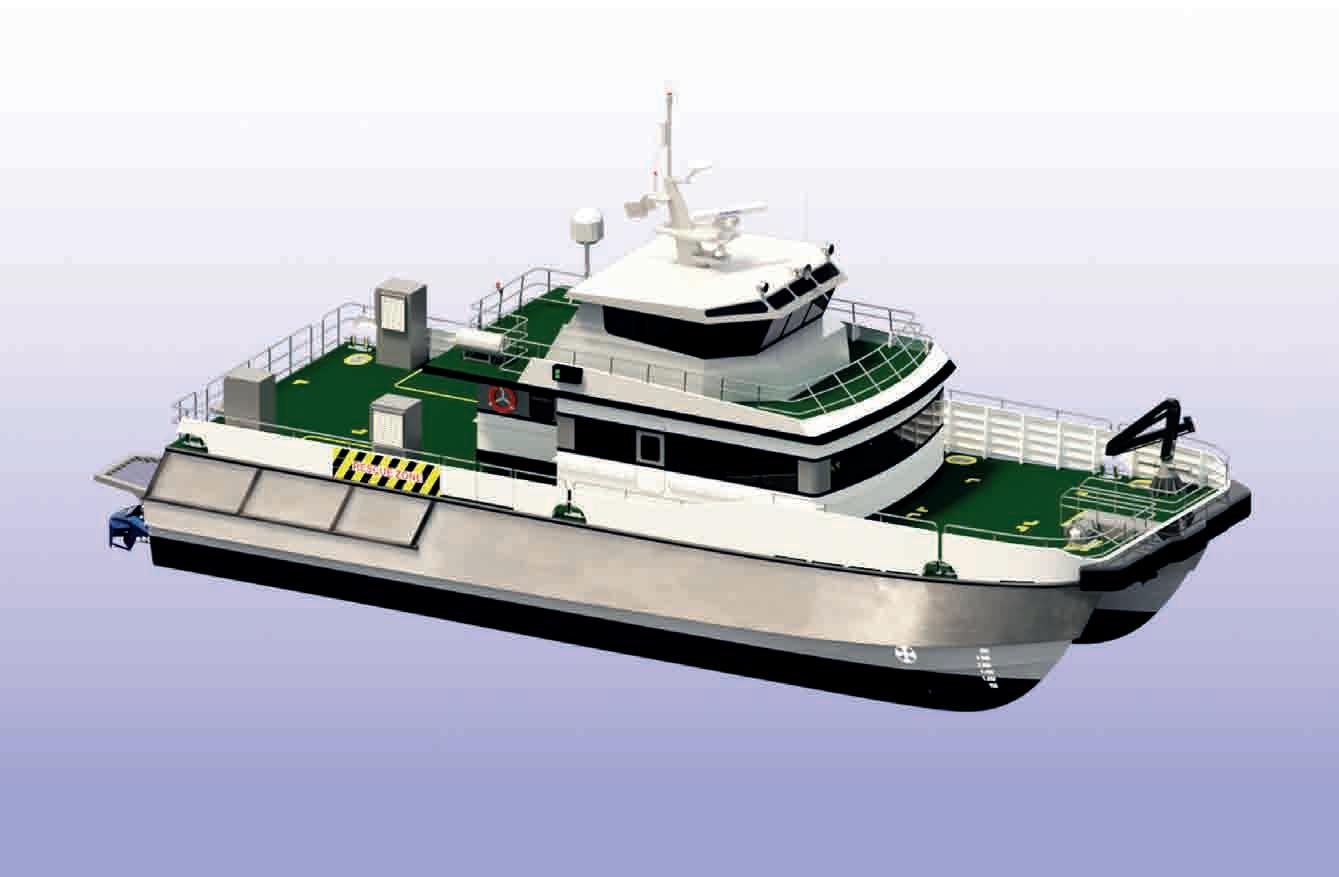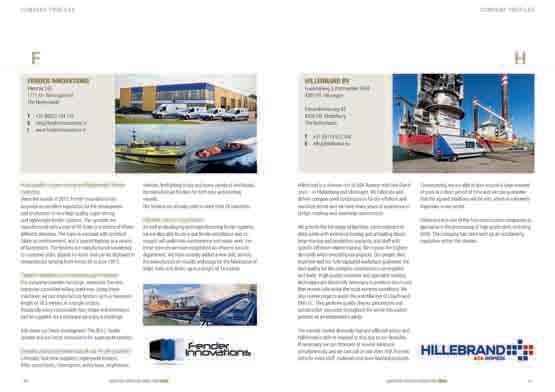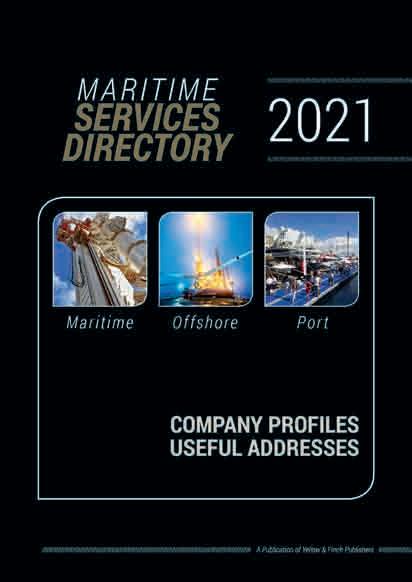
6 minute read
24m South Class CTV enters the market
The 24m South Class is essentially a Mk II modernised update of the hugely successful original South Boats range of CTVs.
A NEW CLASS OF CATAMARAN CTV DESIGNED BY AD HOC MARINE DESIGNS AIMS TO BRING A SIMPLE NO-NONSENSE VESSEL WITH A WELLPROVEN PEDIGREE TO THE MARKET.
ALL IMAGES COURTESY OF AD HOC MARINE DESIGNS
The new South Class range of catamaran
CTV is not trying to reinvent the wheel but, to put it simply, is trying to improve the offering on the market. The vessels have been collaboratively designed with Due South Designs, pulling together a decade of collective knowledge. The inspiration for the new CTVs is the original South Cats range, designed and produced in the Isle of Wight by South Boats’ founder Clive Jeffrey. AHMD Naval Architect John Kecsmar worked very closely with the original South Boats until 2012, assisting with the DNA naval architecture and structural design of the South Boats range of CTVs. “I’ve known John since we first met in the late Eighties at FBM Marine where we both worked”, recalls Clive Jeffrey. “When I left FBM and formed South Boats, I kept in close contact with John as both he and Nigel Warren assisted me on the technical and structural design aspects of my growing brand of designs at South Boats. We have always remained close friends and it seemed only natural to join forces again to continue our close working relationship and create the Mk II South Class of CTVs at AHMD.”
No-nonsense quality workboats The 24m South Class is the first of these collaborations. It is essentially a modernised
update of the hugely successful original South Boats range of CTVs. A coffee-time chat last year inspired the friends to breathe new life into the old designs. “After Clive sold the company in 2012 and the new owners eventually shut it down, it left a void in today’s market”, explains Mr Kecsmar. “There is very little on offer in terms of good design and quality catamaran CTVs. The original South Boats did not have endless sleeping accommodations on board, and they did not aim for service speeds that were chasing headlines or pushed up the engine size, weight, and cost of the boat. They were fine, honest, no-nonsense quality workboats with renowned seakeeping; boats you could rely on in any weather, which wouldn’t cost a fortune because of endless bells and whistles.” The South Class CTVs also have much lower freeboards than the current class of vessels on the market. “Vessels with high freeboards are prone to violent motions and may well fall foul of the HS-OSC Code”, comments Mr Kecsmar. “And since many of the current crop of CTVs are going for 30 knots or more and have crew sleeping areas akin to hotel spaces – we felt the baby had been thrown out with the bath water. So, Clive and I started over again, but with plenty of hindsight.”
Pedigree and provenance At the time, South Boats built more than 50 vessels, ranging from 10 to 24m in various different configurations. “That pedigree and provenance of those original South Cats are what make this new CTV special”, states Mr Kecsmar, adding that all the main design challenges were conquered during the South Boats boom years. “For example, more deck space was required as the vessels became larger. To create that extra space, the deckhouses were situated directly above the engine room and close to the vents, which caused uncomfortable vibrations and noise levels inside the deckhouse”, he continues. “This resulted in the famous flexibly mounted deckhouse. The amount of R&D that went into those deckhouses to get the right balance between weight saving, structural strength, and fit-for-purpose was no small task.” Most of the original features of the South >>
South Class CTVs are fine, honest, no-nonsense quality workboats with renowned seakeeping.

VISIBILITY is of utmost IMPORTANCE is of EXTRA DISTRIBUTION AT SMM HAMBURG 2020



FACTS & FIGURES
– 4,000 copies – Bonus Distribution at Major Trade Fairs – World Wide Circulation – Maritime Services Directory offers Quick Reference, Product
Information, Purchasing, General Research, Networking and Sales/Marketing


Place a full page company profile for EUR 650 or spread page for EUR 950.




The first-in-class South Class boat is expected to measure 24m in length, though the series will be made available in a range of lengths.

The beam of each South Class vessel will range from approximately 7.5m to 9.2m.

Cats have returned, although some have been tweaked a little or updated. “The new hull design is based upon the same advanced chine hull, developed in conjunction with more than ten years of construction and in-service feedback from those original vessels, as well as our hydrodynamic tweaks”, describes Mr Kecsmar. “This has resulted in a hull design with very good internal volume, roll damping, and retaining the superior seakeeping qualities. While the changes are minor and subtle, they can reduce resistance by as much as 5%.”
Fully customised The first-in-class South Class boat is expected to measure 24m in length, though the series will be made available in a range of lengths. “We currently have enquiries for a 22m, 24m and a 26m”, reveals Mr Kecsmar. “Those boats in the UK Workboat Code range will span 15 to 24m in length and will carry up to 12 turbine technicians. The South Class boats designed to HS-OSC Code specifications will be able to accommodate up to 36 technicians aboard 24m vessels. For lengths in excess of 24m load line, a maximum number of 60 technicians is possible, as per the HSC-OSC Code.” The beam of each South Class vessel will range from approximately 7.5 to 9.2m, depending on the size and number of technicians carried and the specified deck cargo capacity. The maximum capacity for boats in this class will be 45 to 50t, including a maximum 20t of cargo on a deck strengthened to 1.5t per m 2 . The vessel layout will largely depend on the owner’s wants and needs, but the South Class’ plans provide for a Palfinger PK6500M or heavyduty PK10000M deck crane. The service speeds are in the region of 20-30 knots, depending on payload and configuration. In terms of propulsion, the customer has a number of options. These range from standard fixed-pitch or controllable-pitch propellers to IPS drives or waterjets with engine options to match, including Scania, MAN, Caterpillar, Yanmar, MTU, as well as Wärtsilä’s new W14, all suited to the South Class format.










